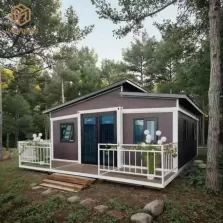Expandable Container Houses: Materials, Benefits, Construction, and Costs
Nov. 14, 2025
Best Materials for Expandable Container Houses
The quality of an expandable container house largely depends on the materials used. Key materials include:
Corrosion-Resistant Steel: Most expandable container homes are constructed from high-grade steel, ensuring durability, weather resistance, and long-term structural stability.
Insulation Materials: To maintain comfortable indoor temperatures, materials such as spray foam, rock wool, or high-density polyurethane panels are used to provide thermal efficiency and soundproofing.
Eco-Friendly Components: Many manufacturers incorporate recycled steel, sustainably sourced wood, and low-VOC paints, contributing to environmentally conscious construction.
Fixtures and Utilities: Pre-installed plumbing, electrical wiring, and energy-efficient fittings enhance comfort while minimizing additional labor during installation.
By combining these materials, expandable container homes achieve a balance of strength, energy efficiency, and sustainability.
Advantages of Owning an Expandable Container Home
Expandable container homes offer several benefits over traditional housing:
Cost-Effective: Lower material and labor costs make these homes an affordable alternative.
Flexible and Modular: Expandable sections and customizable layouts allow the house to adapt as your needs evolve.
Rapid Construction: Prefabricated modules enable quick assembly, reducing construction time from months to days.
Durable and Low Maintenance: High-quality steel frames and corrosion-resistant materials ensure longevity and minimal upkeep.
Eco-Friendly: Repurposing shipping containers and using sustainable materials reduces waste and environmental impact.
Portable: Easy to relocate, ideal for businesses, temporary projects, or changing living circumstances.
These advantages make expandable container houses ideal for residential, commercial, and emergency applications.
Expandable Container House Construction Process
The construction process of an expandable container home typically involves several stages:
Design and Planning: Architects and engineers create layouts tailored to the site, usage, and client requirements, including expandable modules and optional features.
Container Selection and Preparation: Shipping containers are inspected, cleaned, and reinforced as necessary. Structural modifications, such as cut-outs for doors, windows, or sliding panels, are made.
Insulation and Interior Finishing: Containers are lined with insulation, wall panels, and flooring. Utilities such as plumbing, electrical, and HVAC systems are installed during this stage.
Module Assembly and Testing: Expandable mechanisms, such as sliding sections or folding panels, are fitted and tested for smooth operation. Quality control checks ensure structural integrity and safety compliance.
Transport and On-Site Installation: Prefabricated units are shipped to the site. The modules are then connected, leveled, and secured, and final touches like painting or landscaping are completed.
This modular construction allows faster, safer, and more efficient building compared to traditional methods.
Cost of Building an Expandable Container House
The cost of an expandable container home varies depending on size, materials, customization, and location:
Base Price for Standard Units: Small models (20ft) typically start around $10,000–$15,000, while larger models (30ft–40ft) can range from $20,000 to $50,000.
Customization and Upgrades: Adding insulation, high-end finishes, solar panels, or advanced utilities can increase the price by $5,000–$20,000.
Site Preparation and Delivery: Costs for foundation, leveling, and transportation depend on local conditions and distance from the factory.
Total Budget Consideration: On average, a fully equipped expandable container ban home can cost 30–50% less than a conventional house of similar size, making it an economical solution for many buyers.
Conclusion
Expandable container homes offer a modern, cost-effective, and sustainable housing solution. With high-quality materials, modular design, and rapid construction, these homes provide flexibility, durability, and eco-friendliness for residential, commercial, and emergency applications.
By understanding the materials, advantages, construction process, and costs, potential buyers can make informed decisions and enjoy the convenience and innovation that expandable container housing provides.
15
0
0



Comments
All Comments (0)